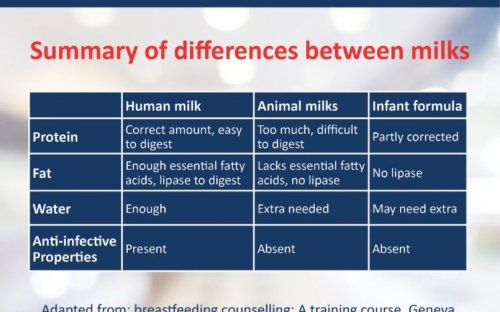How to Choose Formula Milk
Supermarkets are full of baby formula, which is why it can take you hours to choose formula milk. How do you decide? Read on for helpful tips!

The arrival of a new baby brings a lot of joy, doubts, and challenges. Newborns need to feed every few hours, either on breast milk or formula milk. But what are the differences between the kinds of formula milk? How should you choose formula milk? Keep reading to discover helpful tips.
Official recommendations
The World Health Organization (WHO) recommends exclusive and on-demand breastfeeding during the first six months of a baby’s life. After this time, they recommend gradually introducing other foods while breastfeeding until the child is two years or older.
Official data on breast milk and formula milk
A study by the Journal of the American Dietetic Association analyzed public attitude changes regarding newborn feeding between 1999 and 2003. The data the experts obtained showed that 25% of respondents considered formula milk as good as breast milk. This result represented an increase compared to the 14% the same study registered in 1999.
According to data from the Spanish National Statistics Institute, in this country, breastfeeding predominates over mixed breast and artificial feeding during the first three months of a baby’s life.
The trend changes at six months, when only 24.72% of women continue breastfeeding their babies. At that time, artificial feeding gains popularity, representing 61%, while mixed feeding represents 14%. This change is possibly due to the incorporation of new mothers into their work environments.

Characteristics of breast milk
Breast milk is a living fluid that changes and adapts to the baby’s needs. The breast milk immediately following delivery is known as colostrum, which is yellow. This milk contains everything the baby needs for the first days. Then, the milk becomes whiter, is produced in greater quantity, and has a lighter texture. This is known as mature milk.
Breast milk contains everything necessary a newborn needs to grow. In addition to providing macronutrients and micronutrients, it contains other compounds that promote the development of the newborn’s immune system.
While a mother’s breastfeeding, she should increase her caloric intake (except for alcohol). She must consider that her caloric needs continue to increase, which is why this isn’t the time to make caloric restrictions.
One of the biggest fears of nursing mothers who have to take medication often is whether the drugs affect the quality of their milk. You can check a web page to see if the drug you’re taking is compatible with breastfeeding.
Characteristics of formula milk
Formula milk contains everything a newborn needs to grow and develop. They’re all safe and regulated by the Federal Food, Drug, and Cosmetic Act, 21 USC 321 et seq., and FDA’s regulations implementing the act.
Regarding its composition, there’s no standard composition; each brand has its own. In general, they have a higher protein content than breast milk, and usually contain more micronutrients, such as vitamins and minerals. This happens because, despite the fact that they have more nutrients, they’re less bioavailable than those in breast milk.
On the other hand, one of the drawbacks of breastfeeding is that, sometimes, babies consume more than they need to. The reason behind this is that babies don’t need to make that much of an effort to feed through bottle nipples than by sucking on their mother’s breast. Even so, each baby grows at their own pace, and this must be respected.
What to take into account to choose formula milk or breast milk
Breast milk and formula milk differ, above all, in the amount and type of proteins they contain and in the way in which they provide carbohydrates, as you can see in this table.

To choose formula milk, you have to be mindful of three things:
- The proteins they contain and the relationship between casein and serum protein, the two main proteins in milk.
- The way in which they provide carbohydrates. Lactose predominates in breast milk and, therefore, it should be sought in formula milk. In addition, you must avoid syrups or maltodextrins in formula milk.
- Fat sources. Palm oil is present in breast milk. Despite the fact that it’s an unsustainable choice, it’s nutritionally safe.
Regardless of the lactation method you choose, make sure it respects these pillars:
- Both must be exclusive up to six months and on-demand.
- The baby has to set the rhythm.
- It isn’t surprising that babies sometimes feed less or more and, above all, you shouldn’t force your baby to eat.
- Each baby has their own growth rate.
